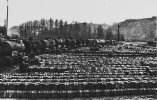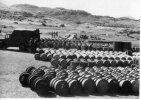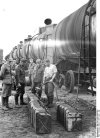Any thoughts? I'd be particularly interested in how German forces supplied fuel to forward units.
Regards
Tim
In the main, the German Army did not use bowsers to supply troops or depots. The available bowsers were used by Luftwaffe units, almost exclusively. In particular, they were used to refuel planes and support vehicles on airports and major airfields. Emergency airstrips and frontline airstrips usually used the standardized 200-liter barrels (with manually operated pumps) for refueling duties. As bowsers were employed in rather low numbers, lorries with barrels had to be used, as well:
German personnel using a British lorrie to refuel a German plane stationed on one of the occupied Channel Islands, but I am not sure whether it's a small motor pump or a hand pump that's mounted on that barrel:
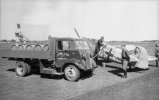
German bowser refueling a Ju 52 in Russia, 1943:
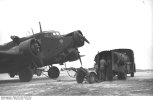
Fuel being transfered from barrels (on a truck) to canisters (on a halftrack), in the Russian winter (March 1944):
Note: the truck's tire-chained.
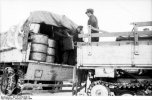
In maintenance stations and supply depots, motorized units were often refueled by using those barrels (with hand pumps), but units were usually refueled with 20-liters canisters, but sometimes even those barrels were brought forward to units right behind the frontline, to speed up the refueling process and to get say an armored unit back to the front asap. On quite a few occasions, trucks with canisters were brought right to the front, where German tanks had just pulled behind houses (out of view of the enemy) in order to get refueled - enabling them to attempt another push. The canisters were usually ferried with truck columns that could either carry a total of 30 tons (medium column) or 60 tons (heavy column), the standard vehicles with offroad capabilities were the
Opel,
Ford,
Mercedes,
Borgward, KHD und NAG Büssing 3-ton trucks.
Horse-drawn columns could carry/move 30 tons.
During the Ardennes offensive, a few bowsers had been sent out from depots to units behind the push, in a desperate attempt to make up for the messed up supply situation where sufficient supplies (especially motor engine fuel) for vital parts of the offensive were still sitting in depots on the right bank of the River Rhine, instead of being stored in the Eiffel region. Most of these bowsers were lost at an early stage already, as they broke down on the rough terrain in the Ardennes (mud and rocks on unpaved roads damaged or broke axles - until the temperature drop made the roads passable for such vehicles again). Prior to the Ardennes offensive, bowsers were used to collect idle fuel residing in closed gas stations all over Germany, in an attempt to use each and every reserve for the build-up of the fuel stocks for the Ardennes offensive. Interestingly, large fuel reserves stored in and around Berlin, reserved for Luftwaffe units and for the German government, were not touched.
There are pictures showing thousands and thousands of German barrels "dumped" on a field in Russia, in the open - way behind the frontlines. IIRC, vital numbers were captured Russian barrels, but there were also barrels with fuel from German refineries, as well as some captured French barrels. If Russian air units would have known that they were just sitting there, they could have carried out a bold strike that would have left a vital part of the German advance units without fuel. Too bad, I can't find the pictures/the background details of that incident right now.
